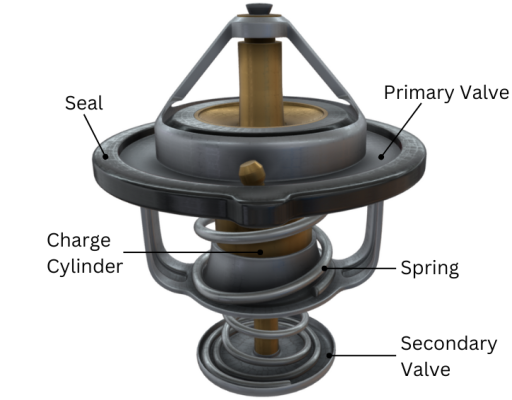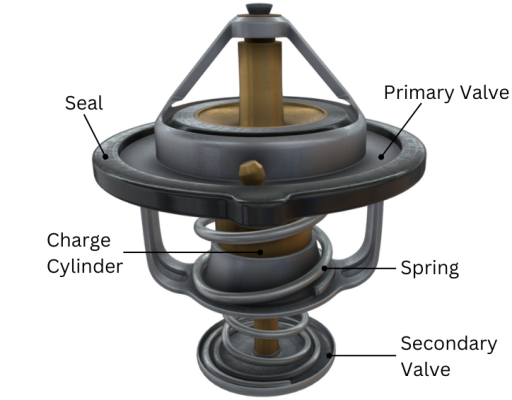I'll keep it brief.
I recently had yet another close shave with my CLK350 Sport.
I had noticed oil floating on the surface of the coolant in the header tank, and feared the worst (head gasket).
A proper diagnosis revealed a perforated oil heat exchange, and so a complete unit with attached oil filter housing was ordered, the cooling system flushed, and oil change underway...
I asked if, whilst everything was apart again .... it's already had a new radiator, hoses, water pump, v belt, gawd knows how many seals... if we could look at the thermostat, which wasn't giving any signs of trouble at all, but should be considered a "service item".
Oh goodness. Bearing in mind the car is 2005, 95,000 miles, with an extremely diligent service history, very well loved... the thermostat rubber gasket was perished, had started to split/shred, and if any of it had come away, would have wreaked havoc in the head gasket.
The thermostat was dated 2004.
Now bear in mind it had a lot of servicing at Mercedes main dealers and errr so called MB specialists.
Not one.
NOT ONE had checked the thermostat in 18 years.
Later, speaking to a guy who runs a MB dealership in Poland, would you believe, he told me that the 350 engines are bullet proof except when owners/mechanics don't check the water pump, thermostat and there is another valve in the cooling system that uses rubber seals.
That valve is being replaced on Wednesday.
The only clue was my engine temperature, despite new rad, hoses etc etc was showing 85° on the display.
With the new thermostat fitted, it's gone down to 80°. But that might be unconnected.
What I will say is this. If your car, whatever model or engine is over 10 years old, or 70,000 miles get the thermostat looked at stat!
They are, like brake hoses, HID bulbs, gearbox mounts, transmission fluid, fuel filters and yes, even radiators, parts that gradually lose efficiency over years, and should really be changed before they fail (especially brake hoses!!!) but they're out of sight, and don't normally give any trouble until the day they do.
My contact said he's known the 350 engines (some were even fitted to vans) to last 1 million kilometres, if carefully maintained, and the aforementioned parts changed as a matter of course, rather than forgotten, or left to a dealership to remember to change (they won't).
I asked how many vehicles he thought were out there with the original thermostats fitted from new, rubber seals dissolving and drifting towards vital apertures? He just said a lot.
I personally don't think it's limited to Mercedes, it's something that nobody even thinks about as wearing out, let alone killing an engine, unless like me you come from a family of car mechanics and got shown a few wrecked motors growing up, and told what parts to never trust if you haven't had them changed yourself.
And like I said, the engine is running fine, cooling system well within spec, but quite literally hours away from disaster.
I recently had yet another close shave with my CLK350 Sport.
I had noticed oil floating on the surface of the coolant in the header tank, and feared the worst (head gasket).
A proper diagnosis revealed a perforated oil heat exchange, and so a complete unit with attached oil filter housing was ordered, the cooling system flushed, and oil change underway...
I asked if, whilst everything was apart again .... it's already had a new radiator, hoses, water pump, v belt, gawd knows how many seals... if we could look at the thermostat, which wasn't giving any signs of trouble at all, but should be considered a "service item".
Oh goodness. Bearing in mind the car is 2005, 95,000 miles, with an extremely diligent service history, very well loved... the thermostat rubber gasket was perished, had started to split/shred, and if any of it had come away, would have wreaked havoc in the head gasket.
The thermostat was dated 2004.
Now bear in mind it had a lot of servicing at Mercedes main dealers and errr so called MB specialists.
Not one.
NOT ONE had checked the thermostat in 18 years.
Later, speaking to a guy who runs a MB dealership in Poland, would you believe, he told me that the 350 engines are bullet proof except when owners/mechanics don't check the water pump, thermostat and there is another valve in the cooling system that uses rubber seals.
That valve is being replaced on Wednesday.
The only clue was my engine temperature, despite new rad, hoses etc etc was showing 85° on the display.
With the new thermostat fitted, it's gone down to 80°. But that might be unconnected.
What I will say is this. If your car, whatever model or engine is over 10 years old, or 70,000 miles get the thermostat looked at stat!
They are, like brake hoses, HID bulbs, gearbox mounts, transmission fluid, fuel filters and yes, even radiators, parts that gradually lose efficiency over years, and should really be changed before they fail (especially brake hoses!!!) but they're out of sight, and don't normally give any trouble until the day they do.
My contact said he's known the 350 engines (some were even fitted to vans) to last 1 million kilometres, if carefully maintained, and the aforementioned parts changed as a matter of course, rather than forgotten, or left to a dealership to remember to change (they won't).
I asked how many vehicles he thought were out there with the original thermostats fitted from new, rubber seals dissolving and drifting towards vital apertures? He just said a lot.
I personally don't think it's limited to Mercedes, it's something that nobody even thinks about as wearing out, let alone killing an engine, unless like me you come from a family of car mechanics and got shown a few wrecked motors growing up, and told what parts to never trust if you haven't had them changed yourself.
And like I said, the engine is running fine, cooling system well within spec, but quite literally hours away from disaster.


